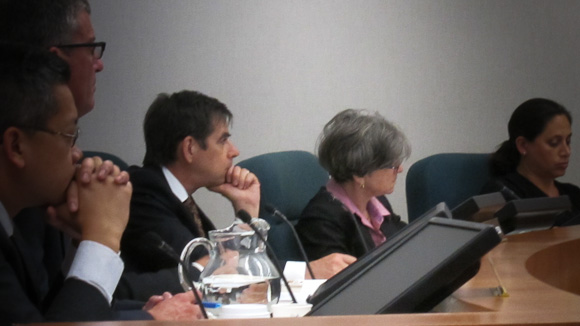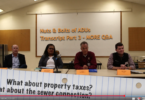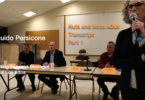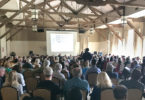ANALYSIS:
LALAHPOLITICO: If the City Council lifts its downtown building moratorium, and unless there is a recession, this southern part of First Street might see some redevelopment sooner than later. Before that happens — judging by my walkability inspection — yes, it would be desirable to improve sidewalk setbacks somehow.

Figure 15: This First Street office building from the 1990’s(?), uncharacteristically has a generous building setback from the sidewalk. Developer Incentives back then?
Of Setbacks and Developer Incentives…
This First Street office building from the 1990’s(?) in Figure 15 has an uncharacteristically generous setback from the sidewalk. How come? Developer Incentives back then? How do 2015-16 economic realities affect what setbacks we can realistically expect from future much needed redevelopment of our sorry-looking south First Street?
At it’s Jan. 7, 2016 presentation to the PTC, the ad hoc Downtown Buildings Committee suggested changes to zoning code language that set hard minimum setbacks. The Planning Commission said that was too prescriptive and probably a “taking” of property rights.
Instead the PTC expressed some regret that a few years ago “developer incentives” had been taken away as a tool for Planning and the Council whereby to get better buildings, where “better” apparently could include “voluntary” building setbacks.
Background: The City Council from the Mayor Ron Packard era determined that “developer incentives” were too broad and resulted in unequal treatment, making developers upset. In particular, reducing city parking requirements in exchange for private developer concessions, such as for pedestrian paseos, was made a “no-no” by amending the language of ordinances in 2012.

This award wining downtown Los Altos building benefited from pre-2012″developer incentives” and was allowed to “underpark” in exchange for a “green” transportation plan for its employees and a cash payment to the City.
Some old posts about the 2012 changes in developer incentives…
At the recent Jan. 7, 2016 PTC meeting, David Kornfield, City Planner staff, answered some PTC commissioner questions about developer incentives. He said there is a list of allowable TYPES of “public benefits” in the zoning code that does NOT include a developer creating more generous front sidewalk setbacks in exchange for… whatever. He said that type could perhaps be added by Council action.
LALAHPOLITICO: Or perhaps the current City Council could return to the old zoning code that allowed more ad hoc customized use of developer incentives by our Planning and Transportation Commission? Was that how those diverse 1990’s(?) buildings along First Street were incentivized to include some generous setbacks? Through that struckout ordinance?

These two Planning Commissions Joined 2012 Downtown Committee – Jon Baer, Phoebe Bressack — that “tightened” developer incentives. They are on the current PTC as of January 2016.
Century of Pedestrian History … got worse … got better
In the 1920’s and 1930’s most of the commercial First Street buildings had parking spots in front of their shops. There was no sidewalk for much of the frontage as this was a district zoned for services like auto repair, lawn mower repair, laundries, vetinarians. Main and State were zoned for retail goods. People were expected to arrive by car even then apparently. See Figure 3. These First Street parcels were NOT part of the downtown parking district (Main and State) created by the Nelson and Cranston families in the 1940s-50s.
Post WWII some First Street parcels were redeveloped – perhaps from modest single story homes – but sadly with sidewalk setbacks of zero. See Figure 6. It made sense then in the heyday of the the automobile and suburbia.

This two story office along First Street looks ever so much like a ranch home. Maybe it used to be one? Or was the office built to mimic a ranch house?
By the 1990’s that kind of laisser-faire development was apparently out-of-style in City politics. A number of the few small office buildings that were built in the downtown triangle were somehow “encouraged” to have more generous sidewalk setbacks than is required. See Figure 10 or 15. I don’t know why, but a lot of them were built to mimic a residential look and feel.
There certainly was an improvement in those 1990s buildings looks and in pedestrian experience compared to the post WWII construction.
What’s better for Los Altos? Codified setbacks in CDR3 or more flexible Developer Incentives?

Here is another downtown Los Altos office building that seems to mimic our prevalent ranch homes. Looks like the Steve Jobs’s childhood house? But 2-story and bigger.






